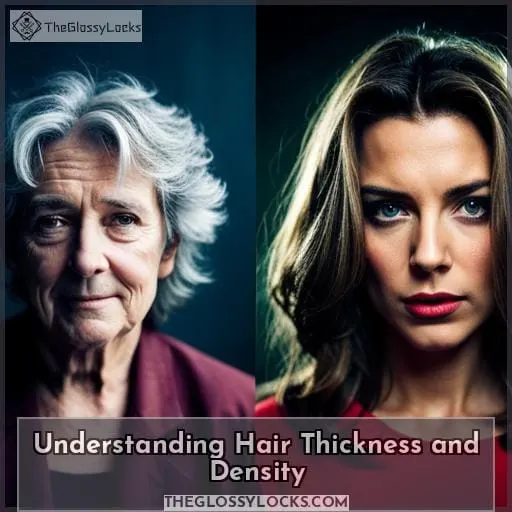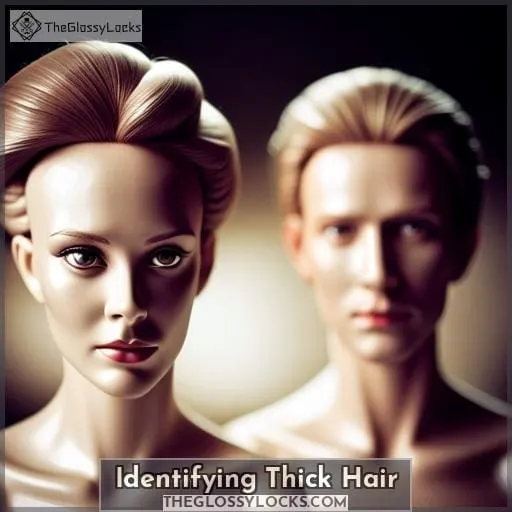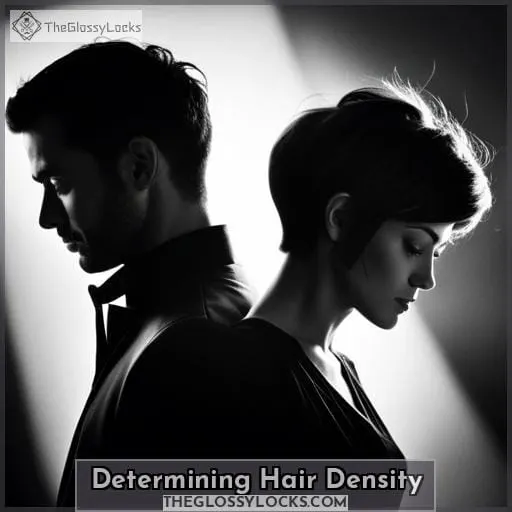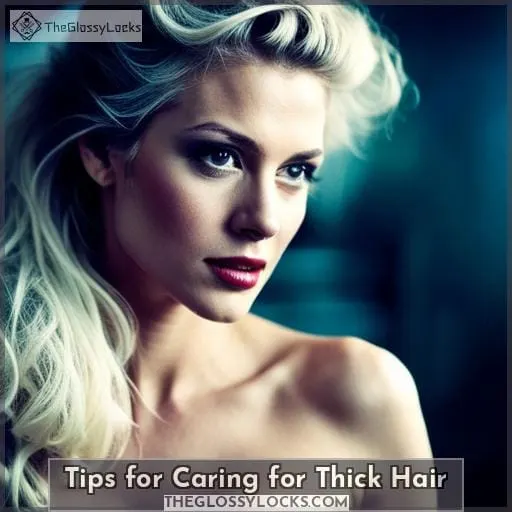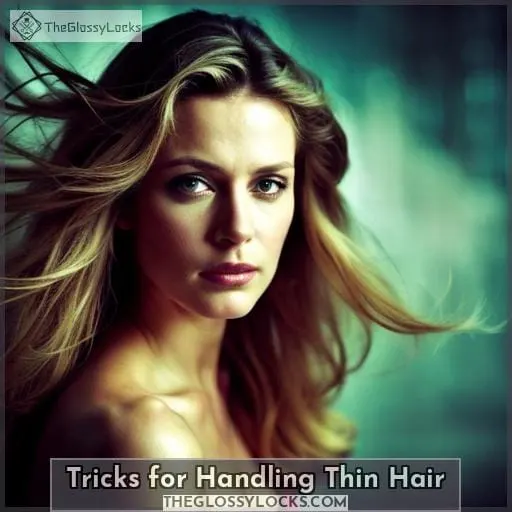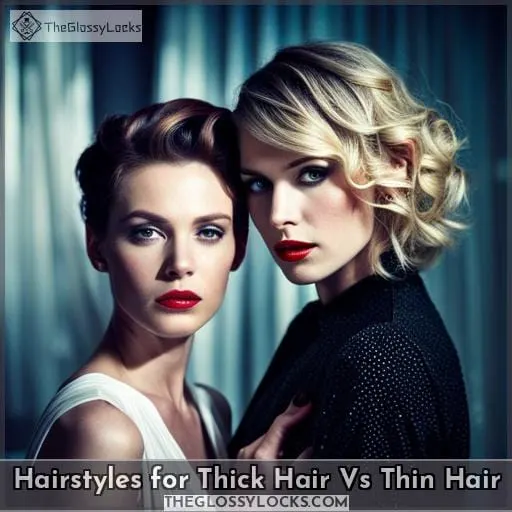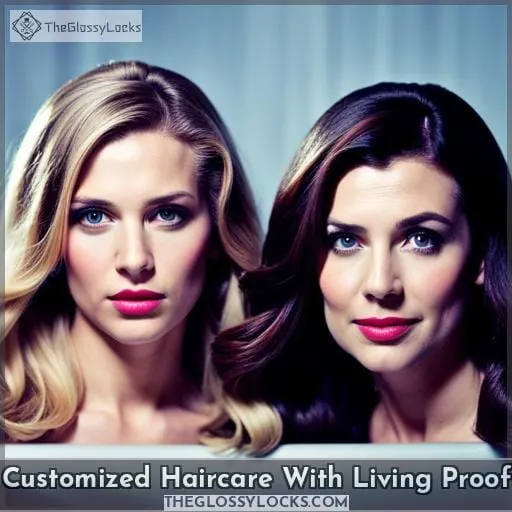This site is supported by our readers. We may earn a commission, at no cost to you, if you purchase through links.
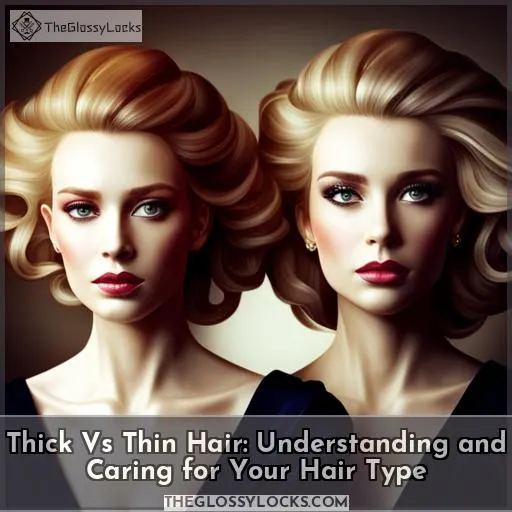 Are you wondering about the difference between thick and thin hair? It’s not as straightforward as it seems. Hair thickness is determined by its diameter, whereas density measures how many strands per square inch are on your scalp.
Are you wondering about the difference between thick and thin hair? It’s not as straightforward as it seems. Hair thickness is determined by its diameter, whereas density measures how many strands per square inch are on your scalp.
Whether it’s stubbornly sparse strands or unruly frizz and tangles causing frustration with styling – there are ways to care for both thick and thin hair types without adding extra damage.
Table Of Contents
- Key Takeaways
- Understanding Hair Thickness and Density
- Identifying Thick Hair
- Identifying Fine Hair
- Determining Hair Density
- Tips for Caring for Thick Hair
- Tricks for Handling Thin Hair
- Hairstyles for Thick Hair Vs Thin Hair
- Customized Haircare With Living Proof
- The Takeaway: Caring for Your Unique Hair Type
- Conclusion
Key Takeaways
- Hair thickness can be determined by examining the diameter, texture, and scalp.
- Hair density is measured by the number of strands per square inch and can be identified through the ponytail test.
- Tailored hair care solutions are essential for addressing the specific needs of different hair types, such as using volume-boosting products for low-density hair and silicone-free shampoo for thin hair.
- Haircut techniques, such as blunt cuts for thick hair and layered cuts for thin hair, can add thickness or provide natural movement.
Understanding Hair Thickness and Density
Understanding your hair thickness and density can help you choose the right products and styles for your unique needs. Thickness is determined by the diameter of strands, while density refers to the amount of hair on the head – both factors should be taken into account to properly assess your individual type.
Hair Thickness Determination
With texture tests, scalp examinations, and the ponytail test, you can determine how fine or coarse your hair is to find the perfect products for your unique hair type. Thickness is determined by feel; coarse textures are dry and rough, while finer strands are almost translucent between two fingers.
The ponytail test helps identify density. Thick hair wraps around a finger once, medium hair wraps around two to three times, and thin hair wraps around more than that. For low-density tresses, volume-boosting products are key. Blunt cuts will add thickness to thicker types, while layers offer natural movement for coarser ones.
Finally, use lightweight nourishing oils on all hair types, as well as leave-in conditioners with oil where appropriate.
Hair Density Assessment
Assess your scalp to determine hair density and get the perfect products for you. The best way to do this is by doing a ponytail test, where you tie your hair back and see how many times it wraps around itself.
If your hair is thick, it will wrap once. If it’s medium-thickness, it will wrap two or three times.
Thick hair conceals the scalp, while thinner strands reveal it. So, when assessing the fullness of your mane, look out for that too. Volume-boosting products are ideal for low-density locks, while nourishing oils work wonders on all types of tresses, regardless of thickness or texture.
Identifying Thick Hair
Identifying thick hair is a simple process that involves performing a texture test and scalp examination. Thick hair care requires the use of protective measures to avoid breakage and nourishing oils for added benefits to maintain healthy locks.
Texture Test
Gently run your fingers through your strands and feel the texture; this is a great way to determine hair thickness. Texture assessment, strand examination, and an understanding of fine vs coarse textures are key for successful hair care.
To take a texture test: 1) Assess whether hair feels rough or soft; 2) Examine individual strands under light to see if they’re thin or thick; 3) Estimate scalp visibility—thick hides it, thin reveals it.
Scalp Examination
Examine your scalp to gain insight into the thickness of your hair. Look for any signs of scalp conditions, such as flaking or dryness, which can indicate thinning.
A thorough analysis will help you determine if you have thick or thin hair and how best to care for it. Consider using nourishing oils specifically formulated for thick locks, while light volumizing products are perfect for those with fine strands.
Hair type is unique. A careful scalp examination can lead to healthy tresses that look great no matter what type they may be!
Thick Hair Care Tips
To protect your thick hair from breakage, try using nourishing oils and blunt haircuts for added thickness.
- Lightweight, nourishing oils to restore strength and prevent breakage.
- Blunt haircuts to add extra volume and texture.
- Volumizing conditioner specifically formulated for thick strands.
- Silicone-free shampoo to keep locks healthy without weighing them down too much.
- Heat protecting sprays so styling won’t cause more damage than necessary!
A customized approach is key when it comes to caring for thicker strands – they need just enough hydration while not getting weighed down by product buildup or heavy ingredients.
Identifying Fine Hair
When it comes to identifying fine hair, the texture test and scalp examination are key. You can also use the ponytail test: If your hair wraps around your finger more than three times, you likely have thin or fine strands.
To care for this type of tress, opt for a silicone-free shampoo and volumizing conditioner to help give body without weighing down hair.
For an extra boost of volume at the roots, try using a texturizing spray before styling.
Determining Hair Density
Determining hair density is a key step in finding the best haircare routine for your unique locks. A great way to identify whether you have thick or thin hair is by performing the Ponytail Test. If it wraps once, then you have thick hair. If it wraps two to three times, you have medium-thick density.
Thick-haired individuals can conceal their scalp, while those with thinner strands will find theirs exposed when looking in a mirror. Hair care tips should be tailored based on one’s individual needs. Low-density tresses may require volume-boosting products, while thicker manes often benefit from nourishing oils and blunt haircuts for added thickness.
The Ponytail Test
You can use the Ponytail Test to quickly and easily assess your hair density. Gather a bundle of your hair at the nape of your neck and secure it with an elastic band. The accuracy of this test lies in comparing texture, scalp visibility, and thickness.
If it wraps once or twice around itself, then you have thick/medium-thickness hair. If it wraps more than three times, then thin/fine strands are present. Hair care tips depend on these factors.
Take a haircare quiz to determine the best maintenance solution tailored just for you!
Concealing Vs Showing the Scalp
Gently tugging at your hair, you’ll quickly notice the stark difference between thick and thin density – with thicker locks concealing the scalp while thinner strands reveal it. This visual impact has a major influence on styling tips and haircare products used for maintenance.
Thick hair can be tricky to work with but offers an opportunity to experiment with length or layers as well as nourishing oils for added protection. Thin hair does not have this luxury, instead relying more heavily on lightweight volumizing products that help create fullness without weighing down delicate strands.
Carefully considering texture when determining scalp concealment will ensure successful outcomes in any hairstyling endeavor!
Hair Density Care Tips
For optimal hair health, tailor your hair care routine to suit your specific density needs. Hair care routines should involve scalp health assessments using a texture test and nourishing oils for thick hair, or volume-boosting products and lightweight conditioner/shampoo for thinning hair.
To keep locks looking their best, consider weekly treatments to repair damage as well as blunt haircuts for added thickness and body on coarse tresses.
Tips for Caring for Thick Hair
Caring for thick hair requires special attention to protect against breakage and nourish the strands with oils. By using products that are tailored to your specific hair type, you can ensure that your thick locks stay healthy and look great.
Protecting Against Breakage
Protect your mane from breakage by using nourishing oils. There are several effective ways to prevent split ends and strengthen thick hair.
Damage control can be achieved through regular deep conditioning treatments, heat protection products, and silicone-free shampoo formulas. Hair strengthening is essential for healthy locks; use leave-in conditioners with oil and opt for lightweight serums that provide lasting hydration without weighing down the hair shafts.
Regular trims help keep ends looking healthy while regular moisturizing helps retain luster in between haircuts – making it easier to manage thick strands of hair! Follow these tips to ensure you’re protecting against breakage so you can enjoy strong, gorgeous locks all year long!
Using Nourishing Oils
Nourish your locks with lightweight oils to keep them healthy and strong! Hair oil offers a range of benefits: it helps lock in moisture, adds shine, controls frizz, and protects against breakage.
When selecting an oil for thick hair types, look for those that are lightweight like argan or coconut oils. Applying the right amount is key; use just enough so that you’re not left with greasy strands after styling.
You can also opt for a nourishing hair mask which will help promote scalp health while adding volume and softness to your locks without weighing them down.
Taking extra care when choosing products based on texture type rather than density creates healthier looking styles no matter if you have thick or thin tresses!
Tricks for Handling Thin Hair
Are you struggling with thin hair? Don’t worry; there are some tricks for handling it. Using silicone-free shampoo and volumizing conditioner can help give your fine strands a boost in volume, making them look thicker and fuller.
Using Silicone-Free Shampoo
To give your delicate hair the pampering it deserves, opt for a silicone-free shampoo that’ll protect its natural shine and help you achieve the fullness you crave.
Silicone-free shampoos have many benefits over their thick hair counterparts. They improve texture, reduce buildups on the scalp and strands, feel lighter in hand, and add less weight to thin locks.
These shampoos contain ingredients like aloe vera or jojoba oil. These ingredients nourish dry ends while adding body to roots without weighing them down.
Don’t be fooled by myths about silicones being bad for your health. They’re only an issue if used excessively. Look into online stores where you can find quality silicone-free shampoos with great reviews from customers who’ve benefited from using them.
Using Volumizing Conditioner
Transform your locks with volumizing conditioner to add body and bounce. Volumizing conditioner benefits all hair types, but is especially helpful for those with thin or fine strands. It helps build texture and volume while nourishing the cuticle layer of the hair shafts.
For coarse or thick hair, look for a lightweight formula that won’t weigh down your tresses.
For fine-haired individuals, use an oil-based leave-in conditioner after shampooing to increase shine and prevent dryness.
With just a few tweaks to your haircare routine, you’ll be able to unlock secrets of unlocking fuller-looking locks no matter what type of head you’re starting from!
Hairstyles for Thick Hair Vs Thin Hair
Are you looking to update your hairstyle but aren’t sure what would best suit your hair type? Thick and thin hair require different styling techniques to create a flattering look. For thick hair, blunt cuts work well for adding thickness, while layered haircuts are great for thinning out the appearance of fine strands.
Blunt Haircuts for Thick Hair
If you have thick hair, a blunt haircut can give your tresses the perfect amount of texture and volume. Blunt cuts can be as short or long as you desire, offering plenty of styling options to best suit your face shape and lifestyle.
When it comes to haircare essentials for thick hair, use nourishing oils before blow-drying to reduce frizziness while providing protection against breakage.
Celebrities like Ruby Rose offer inspiration when looking for new hairstyle ideas. Channel their looks or create something unique! With the right haircare routine in place, achieving even more impressive hair goals is easy.
Layered Haircuts for Thin Hair
Layered haircuts are perfect for adding natural movement to your thin hair. With face-framing layers, you can create volume and definition without weighing down the strands. Styling tips, such as blow-drying with a round brush or using volumizing techniques like backcombing, can further enhance these looks.
Regular trimming of split ends is also important to ensure that your haircut stays healthy and looking good! To maintain thick, healthy hair, follow a tailored haircare routine suited to your unique needs.
Nourishing oils provide essential moisture, while lightweight products help boost fullness and body in thinner locks.
Thin hair benefits from additional texture created by layering, which will keep it looking thicker than ever before!
Customized Haircare With Living Proof
As you know, assessing your hair type and using the right products can make all the difference when it comes to achieving beautiful, healthy-looking locks. Living Proof provides customized hair care solutions for different hair types that are tailored to help meet your individual needs.
Assessing Hair Type
Determining your hair type begins with assessing its thickness and density. Feel the texture between your fingers to gain insight into its unique characteristics.
A Texture Test, Scalp Examination, and Ponytail Test can help identify thick or fine hair. Thick hair is textured, while Fine Hair is delicate. Low-density hair benefits from volume-boosting products, while Thick Hair needs protection from breakage.
Consult the right haircare tips for you. Consider blunt haircuts for added thickness, layers for natural movement, or lightweight nourishing oils depending on density and more!
Use Living Proof’s customized products that cater specifically to each individual’s unique needs.
With proper care and specific treatments tailored just for you, any kind of hair can look great!
Customized Products for Different Hair Types
Finding the right haircare products tailored to your unique hair type can help you achieve a look that’s both stylish and healthy. Living Proof offers customized solutions for thick or thin hair, with personalized product recommendations based on a simple online haircare quiz.
- Get tailored advice from experts to find the perfect products for your needs.
- Select from an array of volumizing or nourishing options designed specifically for thick or thin hair types.
- Take advantage of their Haircare Quiz and get suggestions today!
- Enjoy personalized care with customized recommendations designed just for you!
Living Proof provides effective solutions and helps unlock confidence in every strand, so you can keep up appearances while still protecting against damage – no matter what your specific needs may be.
The Takeaway: Caring for Your Unique Hair Type
No matter your unique hair type, knowing the right care and products for you can make all the difference. On average, individuals with thicker strands have around 150,000 fibers on their head, while those with thinner hair typically have 80,000.
To find out which is closest to yours, it’s best to start by taking a haircare quiz or using a texture test. This will help ensure you get product recommendations tailored specifically for your needs and desired results.
Additionally, if thinning isn’t an issue for you, then scalp health should be considered as well as part of your haircare routine since this affects true thickness.
For thick-haired people, deep conditioning treatments are beneficial in order to keep locks from becoming brittle and breaking off due to weighty styling tools used most often when achieving style goals such as volume or shape control – both important pieces of any look good feel great equation!
For fine-haired folks, lightweight volumizing formulas are suggested, but use caution not to overload locks as this could lead to unwanted breakage.
Ultimately, finding what works best comes down to trial and error, so don’t give up if at first something doesn’t seem quite right.
Conclusion
No matter your hair type, thick or thin, proper care and the right products can help you look and feel your best. Following the guidelines presented in this article, you can understand your hair thickness and density, identify thick or fine hair, and care for your hair type accordingly.
With a few simple steps, you can get the most out of your hair and enjoy the confidence that comes with a great look. Whether you have thick or thin hair, you can now help it reach its full potential with customized hair care solutions.

